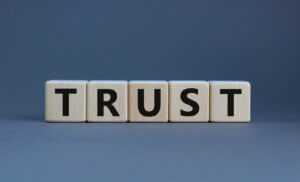|
|

Trust is one of those words that everyone uses, but I suspect if we asked individuals to define it, we would get a wide variety of answers. Trust is very personal. So how does a brand build trust with all of its constituents, internally and externally?
I’ve cherry-picked some of the most important marketing trends that came from a recent Deloitte report that emerged from the pandemic so we can examine them in detail and walk away with some very tangible to-do items.
Over the last couple of weeks, we’ve examined the idea that crisis brings about the need for innovation and evolution and how being a purpose-driven organization can fuel consumer confidence and growth.
This week we’re going to focus on the third of the five, building trust. Here’s a snapshot of the trends I pulled from the report so we can dig a little deeper.
- Being agile.
- Being a purpose-driven organization.
- Building trust.
- Being authentically human.
- Allowing customers to participate.
For this discussion, I’m going to classify trust as what we promise versus what we deliver. The one element of trust that we can probably all agree on is that it’s much easier to lose it than it is to create it in the first place. This is equally true internally as it is externally. After the last volatile political season, the social and civil issues that have come to the foreground, and the pandemic – people are super sensitive to any sign of a misalignment between what a brand says and what it actually does.
The question is: How do we demonstrate this trustworthiness to all of our audiences? There are several elements to consider.
Does our brand demonstrate our humanity? Do we genuinely care about our employees and customers, and how does that show up? If so, according to Deloitte’s research, we’re going to reap some benefits. Customers are 1.6 times more likely to purchase from you rather than a competitor if you are seen as truly caring.
Do we have the capacity to keep our promises? Many businesses go big on what they offer only to discover they bit off more than they could chew. We have to be thoughtful before we boldly hold up an offer. We need to do our due diligence. When we do, according to the research, customers are 2.4 times as likely to buy from us again.
Do we show up the same way every time? One aspect of trustworthiness that often gets overlooked is that we are consistent in our words and actions. I think of this as a brand that is cool and calm and always shows up the same way, no matter how big a crisis or opportunity. That requires an incredible amount of training and communication internally. But when you get it right, customers are twice as likely to recommend your brand, according to the Deloitte data.
How transparent are we? This has always been important, but today it’s essential in an era of fake news and no one trusting anyone. Do we not only openly share information, our choices, and the rationale behind those choices? Are we honest about our motivations? And do we do it in language everyone can clearly understand? When we achieve this on a regular basis, even when we compromise their trust a little (like a data breach), they are 2.8 times more likely to keep buying from us.
The world has always looked to brands to be trustworthy. They wanted to align with a brand they could believe in. But for many decades consumers viewed this as a nice-to-have, not a must-have. Those attitudes and expectations have changed, and we will be judged very harshly if we can’t get this one right.
This was originally published in the Des Moines Business Record, as one of Drew’s weekly columns.
